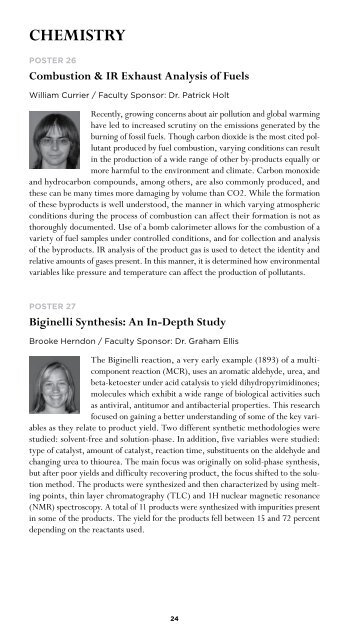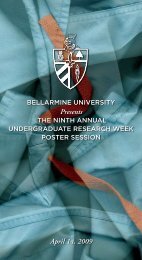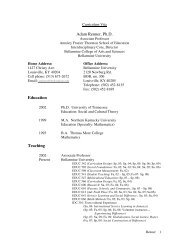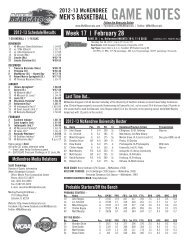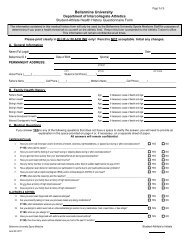The Eleventh Annual Academic Achievement Week - College of Arts ...
The Eleventh Annual Academic Achievement Week - College of Arts ...
The Eleventh Annual Academic Achievement Week - College of Arts ...
You also want an ePaper? Increase the reach of your titles
YUMPU automatically turns print PDFs into web optimized ePapers that Google loves.
CHEMISTRYPoster 26Combustion & IR Exhaust Analysis <strong>of</strong> FuelsWilliam Currier / Faculty Sponsor: Dr. Patrick HoltRecently, growing concerns about air pollution and global warminghave led to increased scrutiny on the emissions generated by theburning <strong>of</strong> fossil fuels. Though carbon dioxide is the most cited pollutantproduced by fuel combustion, varying conditions can resultin the production <strong>of</strong> a wide range <strong>of</strong> other by-products equally ormore harmful to the environment and climate. Carbon monoxideand hydrocarbon compounds, among others, are also commonly produced, andthese can be many times more damaging by volume than CO2. While the formation<strong>of</strong> these byproducts is well understood, the manner in which varying atmosphericconditions during the process <strong>of</strong> combustion can affect their formation is not asthoroughly documented. Use <strong>of</strong> a bomb calorimeter allows for the combustion <strong>of</strong> avariety <strong>of</strong> fuel samples under controlled conditions, and for collection and analysis<strong>of</strong> the byproducts. IR analysis <strong>of</strong> the product gas is used to detect the identity andrelative amounts <strong>of</strong> gases present. In this manner, it is determined how environmentalvariables like pressure and temperature can affect the production <strong>of</strong> pollutants.Poster 27Biginelli Synthesis: An In-Depth StudyBrooke Herndon / Faculty Sponsor: Dr. Graham Ellis<strong>The</strong> Biginelli reaction, a very early example (1893) <strong>of</strong> a multicomponentreaction (MCR), uses an aromatic aldehyde, urea, andbeta-ketoester under acid catalysis to yield dihydropyrimidinones;molecules which exhibit a wide range <strong>of</strong> biological activities suchas antiviral, antitumor and antibacterial properties. This researchfocused on gaining a better understanding <strong>of</strong> some <strong>of</strong> the key variablesas they relate to product yield. Two different synthetic methodologies werestudied: solvent-free and solution-phase. In addition, five variables were studied:type <strong>of</strong> catalyst, amount <strong>of</strong> catalyst, reaction time, substituents on the aldehyde andchanging urea to thiourea. <strong>The</strong> main focus was originally on solid-phase synthesis,but after poor yields and difficulty recovering product, the focus shifted to the solutionmethod. <strong>The</strong> products were synthesized and then characterized by using meltingpoints, thin layer chromatography (TLC) and 1H nuclear magnetic resonance(NMR) spectroscopy. A total <strong>of</strong> 11 products were synthesized with impurities presentin some <strong>of</strong> the products. <strong>The</strong> yield for the products fell between 15 and 72 percentdepending on the reactants used.24


